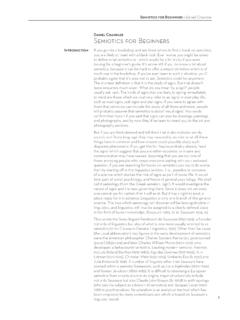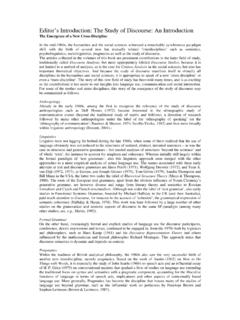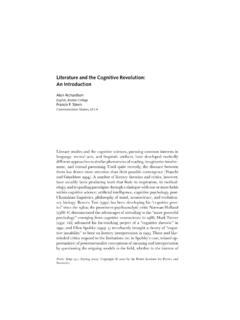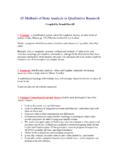Transcription of Chapter 3 - Communication theory
1 58 Chapter 3 - Communication theory Introduction The work of past researchers of Communication theory has influenced both the development of my own theoretical model and my practical research. So before I elaborate on my own work, I shall introduce the origins and development of Communication theory , demonstrating how we have arrived at some of the models that are considered important today. This account is my own, drawn from a variety of sources; the texts that I have drawn from most extensively include Cobley (1996), Silverman (2001) and Littlejohn (2002). My account is however a partial one, and does not seek to provide an exhaustive guide to the development of Communication theory . Rather I have chosen to highlight those parts of Communication theory that are, I feel, particularly relevant to my own research. One particular aspect of Communication that has played a significant role in my study is metaphor.
2 While it forms part of the wider literature on Communication , metaphor itself has been much studied, to the extent that is has developed into a subject in its own right. Consequently, and because it has played such an important role in my own work, metaphor will be dealt with in a separate Chapter that follows this one on Communication theory . The way meaning is generated is one of the leading questions in Communication theory ; this will therefore be a central theme in my discussion. The development of models of Communication , from the relatively simple, to those that are more complex, follows a more or less chronological sequence. So, I too shall present the models ordered roughly by the time that they were developed, beginning with a discussion of the work of the language specialists who introduced the subject of semiotics in the early 1900s. Model 1 meaning in the words: language and semiotics The signs specialists: Saussure and Pierce The early work on human Communication theory began with a focus on language, and on how language is used to generate meaning; meaning is believed to be engendered by the words themselves.
3 The first serious work in this field appeared in the early 1900s with the development of the field of semiotics . Ferdinand de Saussure, a French linguist working in the early 1900s, was one of the first to develop a semiotic theory (Saussure, 1916). Working in the same domain and at much the same time was Charles Sanders Peirce, an American philosopher/logician, who developed models that were related to, but somewhat different from those of Saussure (Peirce, cited by Littlejohn, 2002). Saussure developed the idea that a language is a system of signs, where words are used to signify objects. The language itself is an abstract system, which can exist independently from real-life objects. It is through the spoken or written word (Saussure used parole) that language systems are applied to real-life situations (Saussure, 1916). Saussure argued that no actual link exists between the sign and the object; rather it is an interpretative, or arbitrary link.
4 Saussure also argued that words (or signs) in a language become connected into large communicative units, such as sentences and paragraphs, according to relations between the words. The way that this is done is determined by a sign system , or set of grammatical rules (Cobley, 1996). 60 Peirce s semiotic model was similar to, but more complex than Saussure s. Peirce s model also became more strongly associated with American thinking on semiology, while Saussure is more often represented in European works on the subject. According to Cobley, the principle distinction between Peirce and Saussure is that Peirce s model is based on theories of logic, philosophy and mathematics, rather than on linguistics alone (Cobley, 1996). A key feature of Peirce s semiotic theory is his creation of three semiotic categories, which he named: firstness, secondness and thirdness. The precise meanings of these categories are too complex to explain fully here, but in essence, Peirce described semiosis as a relationship between a sign, an object and an interpretant (or meaning) (Cobley, 1996; Littlejohn, 2002).
5 Since there were three categories, which were each related to each other, they could be represented in a triangular fashion, as shown in Figure Figure Peirce s notion of the triangular relationship between an object, what it is signified by, and how this is interpreted. 61So, concurrently, but independently of each other, Saussure and Peirce developed a line of thinking that treats languages as sign systems, which are governed by rules. For languages such as English, the rules take the form of grammar, syntax etc. Similarly in visual languages, such as signing for the deaf, the rules take the form of sequences of gestures/hand actions etc. each of which has specific meaning. The rules of each sign system form coding systems. In languages such as English we have grammar books and dictionaries that prescribe the coding schema. Cohan and Shires suggest that the relationship between sign system and code is analogous to that between driving and the Highway Code (Cohan and Shires,1996).
6 Cohan and Shires also point out that the rules of a language system are only applied to real-life contexts through discourse. In discourse, the rules of the sign system may be broken, or adapted. So, if language is the code, discourse represents the real-life application of the code. Saussure was the originator of this line of thought, as he made a distinction between language (langue) and speech (parole) (Saussure, 1916). Cohan and Shires develop this idea to suggest that meaning is only developed through the application of language through discourse (Cohan and Shires, 1996). Discourse, they say, consists not only of the spoken words of a language, but also the nuances of verbal articulation, and of non-verbal Communication such as body language. Saussure recognized that one role of Communication is to convey meaning between minds. Nevertheless, it does seem to me that his approach was deeply rooted in a classical analytical worldview.
7 Both Saussure and Peirce treated language as being made up of distinct units - words, sentences and so on. These units, they argued, could be studied independently of their real life contexts, as systems in their own right. This view, I believe, reflects the reductionist approach to studying phenomena, where objects are removed and studied in isolation from their environments. Model 2 meaning in the transfer of information: systems and cybernetic theories of Communication Systems theories of Communication Although semiotics still exists as a field of linguistics today, many other approaches to human Communication have been developed after Saussure and Peirce. Systems theory was one field of study that played a significant role in the development of Communication theory . Up until the time that Bertalanffy, Wiener and others developed systems and cybernetics theories, much of the focus in human Communication studies had been on language, linguistics and semiotics .
8 With the advent of these new systems viewpoints however, Communication systems were re-considered in a new light: as integrated systems. Significantly, human Communication was no longer dealt with as entirely separate and distinct from other communicative processes. Systems theory treated human Communication in the same manner as all other communicative processes, be they engineering systems (such as telephone systems), physical Communication phenomena such as light or energy transfer processes, living biological systems, or entire social systems (Bertalanffy, 1968). These new systems theories made little distinction between the precise Communication processes that were involved in these different kinds of system, rather they looked at the overlying principles of communicative transfer and the influence of communicative relationships within systems. Bertalanffy argued that Communication often concerns the flow of information within a system.
9 He suggested that in many cases, although not always, the flow of information relates also to a flow of energy (Bertalanffy 1968). Bertalanffy also maintained that Communication can be treated like any other system, containing features such as feedback processes and other aspects of control theory ( ). 63 Figure Simple communicative feedback scheme (after Bertalanffy, 1968). Wiener, one of the founding fathers of the field of Cybernetics, also regarded feedback processes as highly significant in communicative systems. Like Bertalanffy, Wiener argued that the fundamental principles of Communication are the same regardless of whether one is dealing with man-made machines and systems, or living organic beings; indeed he argued that human society itself is bound together by the same kinds of communicative principles as any other system (Wiener, 1948). Weiner maintained that Communication is one of the principle means by which systems are coupled to their external environments; and if a system communicates with its external environment, this is one of the features which identifies is as an open system, rather than closed.
10 Information theory In 1949, Shannon and Weaver, inspired by developments in systems theory and cybernetics, introduced a new communicative model that they called information theory (Shannon and Weaver, 1949). In information theory , information is viewed as a measure of the entropy or uncertainty in a system. In the information theory model of Communication , a source produces a message, this message is passed along a channel, to a receiver that interprets the message. The channel has bandwidth that affects the level of information that can be transmitted; bandwidth is a measure of communicative capacity. For example, in modern terms, if we connect to the Internet via a modem, its bandwidth affects how fast we can download data. A channel s bandwidth may also be limited by the form that the Communication has. For example, when speaking on a telephone, the channel is limited to audio-only data; visual information isn t communicated.








